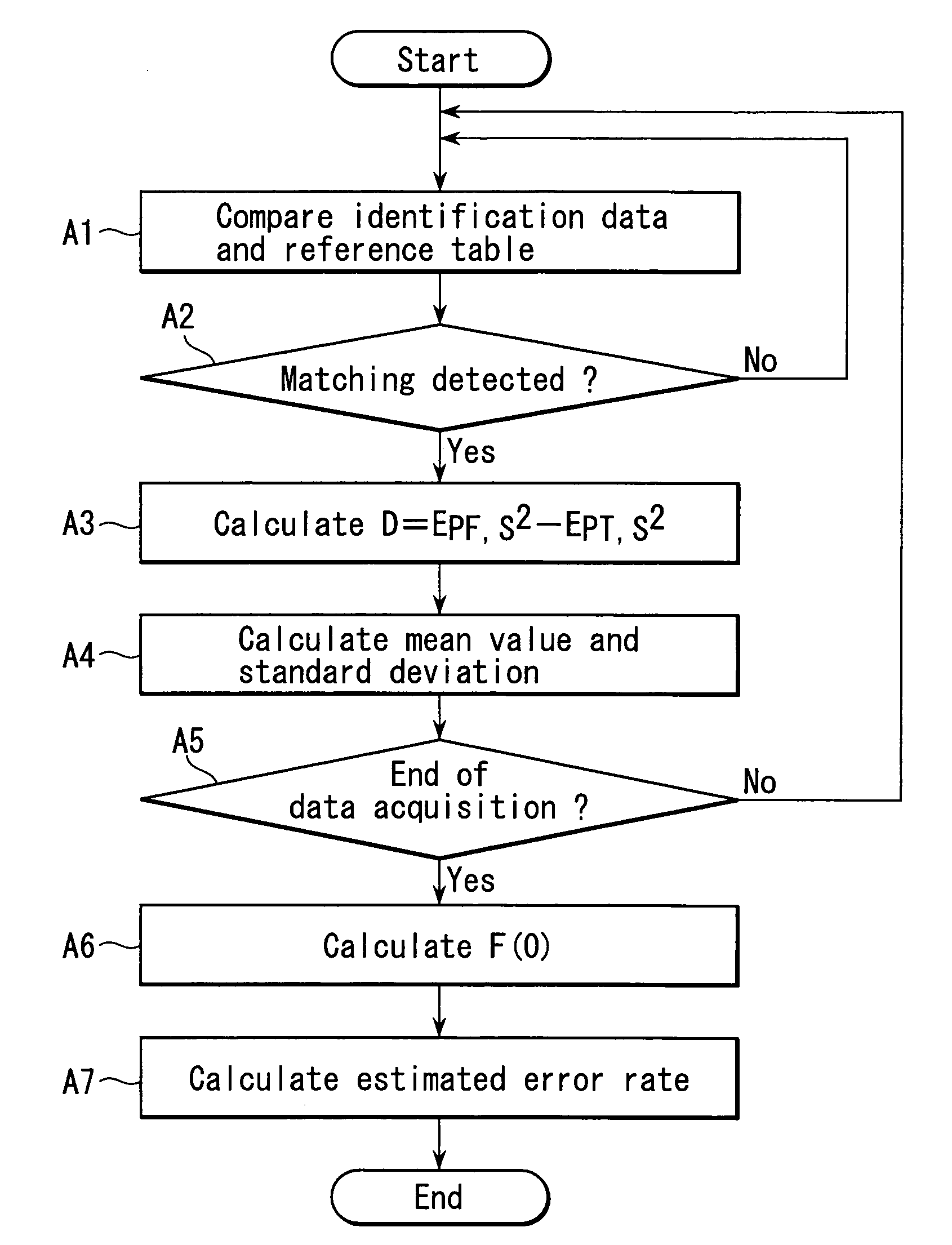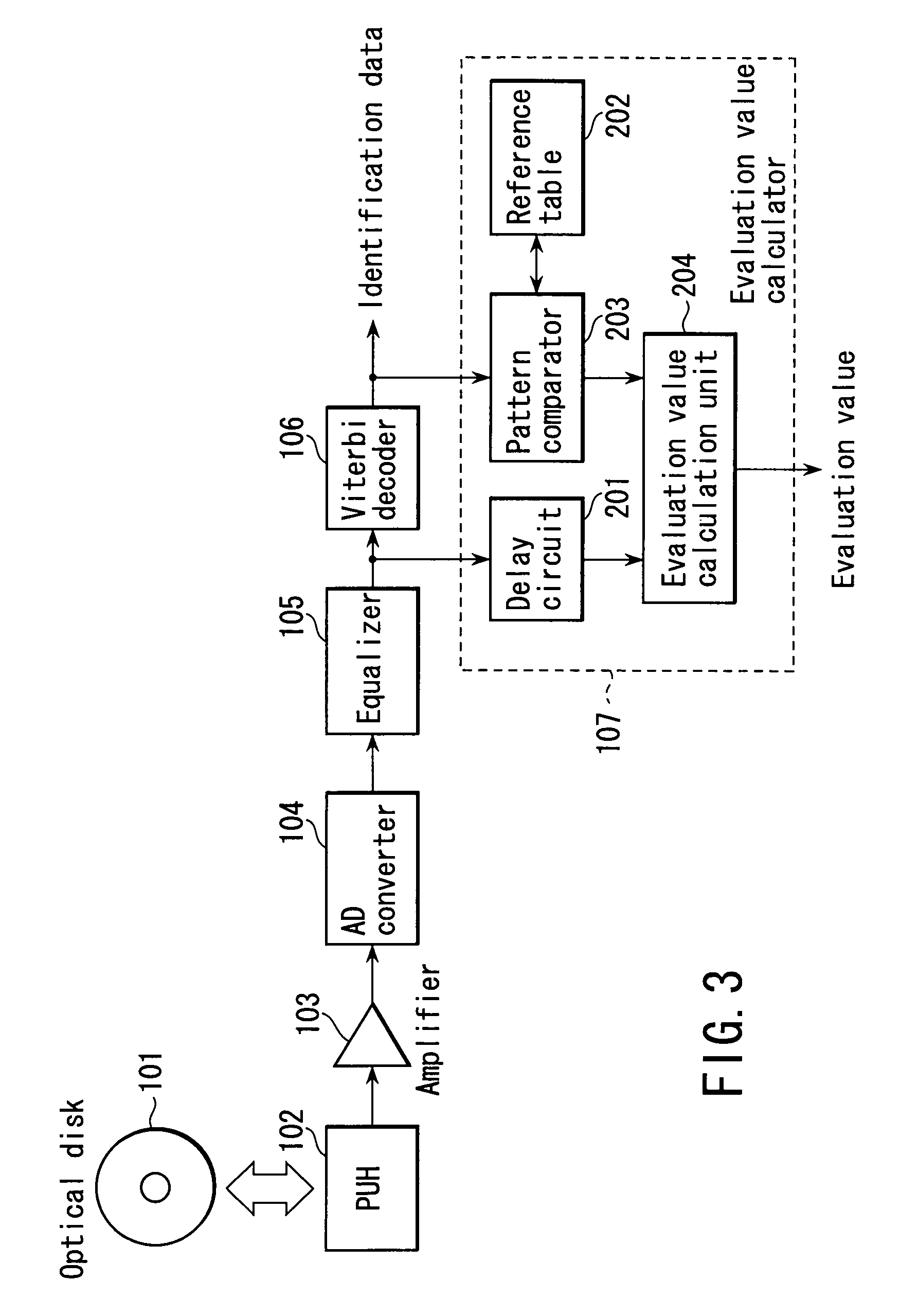Signal evaluation method, information recording/reproducing apparatus, information reproducing apparatus, and information recording medium
a signal evaluation and signal technology, applied in the field of signal evaluation methods, can solve the problems of inability to accurately estimate the error rate and evaluate the signal quality, and achieve the effects of accurate evaluation of signal quality, high reliability, and high reliability
- Summary
- Abstract
- Description
- Claims
- Application Information
AI Technical Summary
Benefits of technology
Problems solved by technology
Method used
Image
Examples
embodiment 1
[0048]FIG. 3 is a block diagram illustrating the configuration of one embodiment of the present invention. Referring to FIG. 3, information, which is recorded on an information recording medium (an optical disk) 101 as marks and spaces, is read out by an optical head device (PUH) 102 as feeble analog signals. An amplifier 103 amplifies the feeble analog signals to have sufficiently high levels. An analog-digital (AD) converter 104 converts the amplified analog signals into digital reproduction signals. An equalizer 105 equalizes the digital reproduction signals so that the digital reproduction signals have waveforms corresponding to a PR characteristic to be used (the digital reproduction signals having such waveforms will be hereinafter referred to simply as “equalization signals”). Then, the equalization signals are supplied to a Viterbi decoder 106 and an evaluation value calculator 107. The Viterbi decoder 106 decodes the equalization signals in accordance with the Viterbi algor...
embodiment 2
[0075]FIG. 5 illustrates a waveform adjusting circuit that uses the estimated value described above or an intermediate calculation result used for calculating the estimated value. In FIG. 5, the same reference numerals as used in FIG. 3 represent similar or corresponding structural elements. In the system shown in FIG. 5, a recording waveform generator 301 makes recording parameter adjustment in such a manner that the evaluation value or the intermediate calculation result satisfies a predetermined value. Recording data subjected to the adjustment is supplied to an optical head device 102.
[0076]A description will be given as to how recording parameters are adjusted by referring to the reference tables described in tables (1-1) and (1-2) and using the mean value and standard deviation calculated for each group. Let us assume that the mean value is μ and the standard deviation is σ. In this case, the larger the value of Z (=μ / σ) is, the lower will be the probability of pattern T being...
embodiment 3
[0078]FIGS. 6 and 7 show the third and fourth embodiments of the present invention. The embodiment shown in FIG. 6 will be described prior to that shown in FIG. 7. Referring to FIG. 6, information, which is recorded on an information recording medium (an optical disk) 101 as marks and spaces, is read out by an optical head device (PUH) 102 as feeble analog signals. An amplifier 103 amplifies the feeble analog signals to have sufficiently high levels. An analog-digital (AD)converter 104 converts the amplified analog signals into digital reproduction signals. An equalizer 105 equalizes the digital reproduction signals so that the digital reproduction signals have waveforms corresponding to a PR characteristic to be used. Then, the equalization signals are supplied to a Viterbi decoder 106, a first evaluation value calculator 107 and a second evaluation value calculator 108.
[0079]The Viterbi decoder 106 decodes the equalization signals in accordance with the Viterbi algorithm, thereby ...
PUM
| Property | Measurement | Unit |
|---|---|---|
| Euclidean distances | aaaaa | aaaaa |
| Hamming distance | aaaaa | aaaaa |
| area | aaaaa | aaaaa |
Abstract
Description
Claims
Application Information
 Login to View More
Login to View More - R&D
- Intellectual Property
- Life Sciences
- Materials
- Tech Scout
- Unparalleled Data Quality
- Higher Quality Content
- 60% Fewer Hallucinations
Browse by: Latest US Patents, China's latest patents, Technical Efficacy Thesaurus, Application Domain, Technology Topic, Popular Technical Reports.
© 2025 PatSnap. All rights reserved.Legal|Privacy policy|Modern Slavery Act Transparency Statement|Sitemap|About US| Contact US: help@patsnap.com



